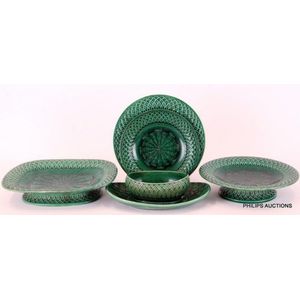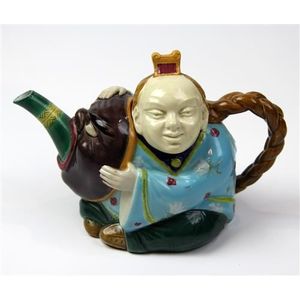
Minton Blue and Yellow Majolica Jug with Face Mask Spout
Minton blue and yellow majolica antique English jug with face mask spout, 19th century, impressed 'Minton', 24.5 cm high

Minton Majolica Butter Pot with Goat Finial, 19th Century
Minton antique English majolica butter pot and cover with goat finial, 19th century, impressed 'Minton', 13 cm high, 20 cm wide

Minton Majolica Jester Beer Stein with Renaissance Characters, 1867
A Minton Majolica jester beer Stein, moulded in relief with Renaissance style characters, pewter mounts and jester finial, impressed date mark for 1867, height 34.5 cm.

Mintons Majolica Oyster Serving Set with Roman Gods Platter
A fine serving platter and three majolica oyster serving dishes by Mintons, mid 19th century, the platter decorated with panels of reclining Roman gods Juno, Neptune, Mercury and Jupiter within landscapes, on a marbled blue and green ground; the oyster…

Whimsical Cat Majolica Jardiniere: Playful Cushion Holder, 38cm Wide
Large Minton style Majolica jardiniere, depicting a playful cat lying on a cushion holding the jardiniere, 38 cm wide

Minton Green Glazed Majolica Dinner Service
A fourteen piece Minton green glazed Majolica part dinner service, impressed 'Minton Bb' mark, diamond registry mark for 1860, late 19th century, the striking Minton majolica service, comprising 6 dinner plates, 3 side plates, three footed rectangular…

Mintons Majolica Seaweed & Mermaid Vase, 19th Century
Mintons antique English majolica vase decorated with seaweed and mermaid putti figures, 19th century, impressed mark to base, 41 cm high. Provenance: Christie's Auctions, 1998

Minton Majolica Dove Bowl - 1870s
Minton majolica 'Dove' centrepiece bowl, circa 1870s, 14 cm high, 28 cm wide

Minton Majolica Oyster Tower, 19th Century
Minton antique English majolica revolving oyster tower, mid 19th century, stamped 'Minton', 25 cm high, 30 cm wide

Antique Minton Majolica Lidded Bowl with Goat Finial
Good Antique Minton majolica lidded bowl figure of reclining goat finial to lid, on dual handle bowl, with embossed decoration, indented mark to base, diameter 21 cm

Victorian Cobalt Blue Minton Majolica Jardiniere with Mask Handles
Victorian Minton majolica jardiniere dual mask head handles, to cobalt blue bowl, circa 1880, height 21 cm

Majolica Cockatoo Statue by Minton, 1870
Minton majolica 'Cockatoo' statue, circa 1870, stamped 'Minton, England, 37 cm high. Provenance: Mossgreen Auctions, the Trevor Kennedy collection, Sydney, Feb. 2017.

Turquoise Minton Oyster Plate, 23 cm Diameter
A Minton turquoise Majolica oyster plate, diameter 23 cm

19th Century Minton Majolica Jardiniere with Rose Decoration
Large 19th century Minton majolica jardeniere with applied rose decoration against blue ground and raised on three feet, height 31 cm, diameter 33 cm

Minton Majolica Game Tureen with High Relief Cover
A Minton majolica game tureen and cover, the body decorated with oak leaves on a basket woven ground, the cover modelled in high relief with game grouse, duck and a hare on a background of oak leaves and ferns, the interior a bright turquoise. Restoration…

Minton Holly & Putti Charger 1859
Minton wall charger Majolica Earthernware. Decorated with a band of holly & berries. Four putti in different poses. The bottom putti bearing a shield. With Crystal Palace Art Union. Impressed back stamp Minton & date mark 1859. Diameter 40 cm. (a/f minor…

Majolica Bacchus Jardiniere by Carrier Belleuse
Minton Majolica Carrier Belleuse design jardiniere, of two handled campana form moulded with two figures of Bacchus impressed mark (head of one figure chipped, hairline crack to shoulder of other)

Majolica Pan Ewer, Minton, 1860s, 45cm
Good Minton Majolica Pan ewer circa 1860s, 45 cm high approx.

Pugin Majolica Revolving Tray, Medieval Rose Window Motif
Augustus Welby Northmore Pugin for Minton, Majolica revolving luncheon tray, shape no. 799, of circular shape, decorated with medieval rose window motif and eight fleur-de-lys, restored base (A/F), height 10.5 cm, diameter 46.5 cm

Majolica Heron Jardiniere and Stand
Minton style Majolica jardiniere and stand basket weave jardiniere, the stand formed as a heron amongst foliage

Minton Majolica Tower Jug with Jester Finial
Minton Majolica 'Tower' jug, pewter mounted with jester finial, designed by Hugues Protat, circa 1870, impressed 'Minton, 1231, G, 32' cm high

Minton Majolica Cherub and Dove Comport
A Minton Majolica cherub and dove figured comport, year cypher for 1864 shape 980 17 cm high. Note: For a similar example see 19th century Ceramics including Majolica, Christies, South Kensington, 30 May 2002, lot 46.

Thistle Jardiniere with Fauns and Goats Decoration
Minton porcelain Majolica jardiniere, of thistle form, decorated with scene of fauns and goats, above lower lobed body, flanked by mask handles, on a circular foot, in tones of pink, blue and green, height 25 cm

Mintons Mermaid Centrepiece with Double Clam Shell Bowl
A Victorian majolica Mintons mermaid centrepiece, the two naked maidens flanking the double clam shell centre bowl, impressed marks including #1182. Some repair to one rope leaf support. Length 44 cm

Antique Minton Majolica Jardiniere with Putti and Flowers
Rare antique Minton majolica large jardiniere, with leaf capped ends, central C scroll cartouches with putti at play with garlands of flowers. Impressed Minton, 28 cm high, 56 cm wide, 40 cm deep

Antique Minton Majolica Jardiniere with Putti and Garlands
Rare antique Minton majolica large jardiniere, with leaf capped ends, central C scroll cartouches with putti at play with garlands of flowers. Impressed Minton, approx 28 cm high, 56 cm wide, 40 cm deep

Minton Cherub Lamp
The base of a Minton majolica comport modelled with three draped cherubs and converted to a lamp

Majolica Sulphur Crested Cockatoo Figure by Mintons
Mintons, a majolica figure of a sulphur crested cockatoo, circa 1890, stamped: Mintons England, 37 cm high

Victorian Minton Monkey Teapot and Cover
A Victorian Minton majolica monkey teapot & cover, 1874, modelled as a monkey with its arms and legs wrapped around a nut, its tail forming the handle and its head the cover, the spout as a piece of bamboo, the animal wearing a blue jacket moulded with…

Majolica Triple Cherub Centrepiece Bowl by Hughes Protat
Minton Majolica triple cherub centrepiece bowl depicting three putti holding a flower basket, modelled by Hughes Protat, stamped to the base. Height 30 cm

Minton Majolica Putti Sweetmeat Dish
Minton Majolica spring & summer sweetmeat serving dish depicting two putti carrying a shell, after a model by Albert carrier-Belleuse, on a oval pedestal base, stamped 'Minton'. Condition, good, minor wear to the base. Height 29 cm

Majolica Rams Head Jardiniere with Under Plate
Minton Majolica rams head decorated jardiniere with under plate having a tapered body decorated in relief with floral & fruit swags on a spirally fluted turquoise ground, the top edge with an egg & dart pattern in blue, yellow gold & white, the bottom…

Minton Majolica Oyster Plate with Fish and Shells
Minton Majolica Oyster plate decorated with five spiralling fish on a brown ground & six turquoise shell form dishes, stamped 'Minton' to the base.

Minton Majolica Monkey Teapot
Minton Majolica monkey teapot circa 1870, modelled wearing a Chinese waistcoat clutching a coconut, his head forming the cover, his tail the handle, with impressed marks 'Mintons 1844' to the base. Condition, good, minor wear to the base. Length 23 cm

Majolica Stork Umbrella Stand with Eel and Frog
Minton Majolica life size stork umbrella stick stand standing on one leg atop a rocky mound, an eel clasped in its beak, a frog beneath its foot, the stand formed by tall bullrushes & water-lily pads, shape number 1910. Condition, good to fair, minor…

Minton Majolica Game Pie Dish with Hunting Scene
Minton Majolica game pie dish the lid relief moulded with a hunted hare, grouse & duck on a bed of ferns, the body decorated with oak leaves onto a basket woven ground, decorated in a predominantly green & brown glaze with turquoise interior, stamped to…

Minton Renaissance-style Majolica Ewer with Putti and Caryatid
Minton Majolica ewer & under plate in the Renaissance style, having various putti figures, floral motifs & a winged caryatid to the high handle, the base of flared flutes with stylized flower heads, stamped 'Minton 472' to the base, modelled by modeled by…

Majolica Dolphin Fruit Stand
Minton Majolica dolphin fruit stand the top bowl supported by an entwined dolphin. Height 25 cm

Cobalt Blue Lion Head Jardiniere by Minton Majolica
Minton Majolica cobalt blue glazed jardiniere on a cobalt blue ground decorated with six lion heads, each over a claw foot base.

Minton Majolica Chinaman Teapot
Minton Majolica Chinaman teapot moulded as a Chinese gent dressed in a traditional turquoise robe, holding a theatrical mask, with his plaited ponytail forming the handle, stamped 'Mintons 8381' to the base. Condition, good, minor wear to the base. Height…

Minton Majolica Asparagus Cradle with Floral Medallions
Minton Majolica asparagus design cradle moulded as thirteen asparagus spears on two stands over a rounded recangular plate with a geometric border, each side with a floral medallion. Stamped to the base. Condition, good, minor wear to the base. Height 27…

Minton Majolica Jester Castle Jug with Pewter Lid
Minton Majolica 'Jester' pewter lidded Castle jug with a jesters head finial upon a pewter lined lid, the body decorated with figures dancing around a castle wall, with a twisted branch as a handle. Stamped 'Minton 1231'. Restored lid. Height 34 cm

Antique Chinaman Teapot in Minton Style Majolica
English antique Majolica Minton style cobalt glaze Chinaman teapot moulded as a Chinese gent dressed in a traditional turquoise robe, holding a theatrical mask, with his plaited ponytail forming the handle.

Oversized Majolica Jardiniere with Goat Head Handles & Cherubs
Mintons oversized Majolica footed jardiniere with bright colourful detail having two applied goat head handles, four cherubs support base & various fruit, model no 990, date mark 1877, designed by Albert Ernest carrier-Belleuse. Condition fair, some…

Minton Majolica Garden Stool with Floral Design
Minton Majolica garden stool, c. 1870 with applied polychrome flowers and foliage on blue and green ground, incised Minton mark to base, minor hair line crack to the top. Height 52 cm. Provenance: Purchased from Reflections, 1987. Private Collection,…

Mintons Majolica Jardiniere on Stand, Floral Design, 103cm
Mintons Ltd Majolica jardiniere on stand. Mintons Ltd Majolica Jardiniere on stand the tulip form jardiniere resting on a tapered & splayed column stand, tubeline decorated in green, aqua, & yellow glazes, displaying stylised floral designs. Condition…

Damaged Minton Shell Plates with Wear
Four Minton Majolica Shellform plates condition - one plate multiple chips, signs of wear to all four

Majolica Putto with Bulrushes, 1867
Minton 19th century Majolica figure of putto carrying bulrushes, dated 1867. Height 27 cm

Majolica Figural Salt Set, 1862
Minton 19th century Majolica figural salts of boy & girl set upon trunk form base, dated 1862. Height 19.5 cm

Victorian Satyr Ewer by Minton
Victorian Minton Majolica ewer. Satyr mounted to column base. Impressed 'Minton 843,' c.1860s. Height 46 cm

Minton Majolica Jardiniere on Stand, 1880
A majolica jardiniere on stand attributed Minton, circa 1880 the pedestal of bulbous form with moulded blue flowers and green foliage on a yellow ground with conforming jardiniere. 95 cm high.







 Loading more...
Loading more...